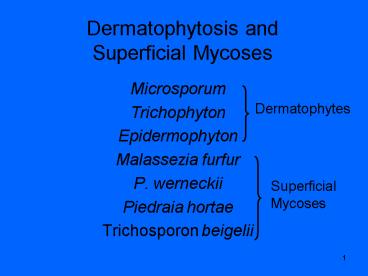Dermatophytosis and Superficial Mycoses - PowerPoint PPT Presentation
1 / 10
Title:
Dermatophytosis and Superficial Mycoses
Description:
... outer layer of the scalp, glabrous skin, and nails causing tinea or ringworm ... Classical 'Ringworm' Lesion. Dermatophytes. Taxonomic classification ... – PowerPoint PPT presentation
Number of Views:3127
Avg rating:5.0/5.0
Title: Dermatophytosis and Superficial Mycoses
1
Dermatophytosis and Superficial Mycoses
- Microsporum
- Trichophyton
- Epidermophyton
- Malassezia furfur
- P. werneckii
- Piedraia hortae
- Trichosporon beigelii
Dermatophytes
Superficial Mycoses
2
Mycoses of Skin, Hair, and Nails
- Mycoses of skin, hair, and nails are grouped
according to which layers are affected and
clinical manifestations - Superficial mycoses are fungal infections of the
outermost keratinized (cornfield?) layers of the
skin or hair shaft resulting in essentially no
pathological changes. No cellular immune
response in elicited minimal humoral host
response - IgA - These mycoses are largely cosmetic involving skin
pigmentation or forming nodules along distal hair
shafts often asymptomatic host is unaware
3
Mycoses of Skin, Hair, and Nails
- The superficial mycoses are
- Malassezia furfur ? tinea versicolor (seborrhea?,
dandruff?) - Phaeoannelomyces werneckii ? tinea nigra
- Piedraia hortae ? black piedra
- Trichosporon beigelii ? white piedra
- Dermatophytosis involve deeper layers of skin,
hair, and nails with varied clinical
manifestations and are caused by species of the
fungal genera Trichophyton, Epidermophyton, and
Microsporum (in order of commonality). - Your text classifies these under superficial
- Other sources classify them under cutaneous (U.
of Adelaide)
4
Dermatophytes
- Dermatophytes are keratinophilic fungi they
possess keratinase allowing them to utilize
keratin as a nutrient energy source - They infect the keratinized (horny) outer layer
of the scalp, glabrous skin, and nails causing
tinea or ringworm - Although no living tissue is invaded (keratinized
stratum only colonized) the infection induces an
allergic and inflammatory eczematous response in
the host - Lesions on skin and sometimes nails have a
characteristic circular pattern that was mistaken
by ancient physicians as being a worm down in the
tissue - These lesions are still today called ringworm
infections even though the etiology is known to
be a fungus rather than a worm
5
Classical Ringworm Lesion
6
Dermatophytes
- Taxonomic classification
- They belong to the phylum Deuteromycota (Fungi
Imperfecti) - They are hyaline moulds (transparent / white)
- Three genera comprise this group
- Microspourm
- Trichophyton
- Epidermophyton
7
Dermatophytes
- Classification
- There are many species of dermatophytes but only
a few are commonly encountered in developed
countries - Identifying the dermatophytes to the species
level is not usually required because
antimicrobial therapy is the same for all isolates
8
Dermatophytes
- Direct Examination
- Treating skin and nail scrapings and snippets
of hair with potassium hydroxide (KOH dissolves
keratin but not chitin - hyphae) is usually very
effective in detecting dermatophyte hyphae in
clinical specimens. - The addition of calcofluor white (1,4 polymer
specific fluorochrome dye) and dimethylsulfoxide
(DMSO) to the KOH and viewing with a fluorescent
microscope is recommended. DMSO is a non-polar
surfactant (wetting agent) which aids in clearing
of the keratin by making KOH more soluble in the
sample.
9
(No Transcript)
10
Dermatophytes
- Direct Examination
- The pattern of growth in the infected hair taken
directly from the patient is characteristic of
some dermatophytic fungi - Some grow only inside the hair shaft (endothrix)
- Some grow inside and outside the hair shaft
(ectothrix)































